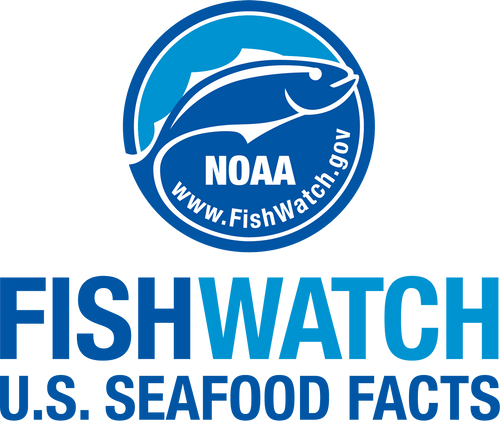 A bin of farmed geoducks. Credit: Megan Ewald/NOAA Fisheries
A bin of farmed geoducks. Credit: Megan Ewald/NOAA Fisheries
A bin of farmed geoducks. Credit: Megan Ewald/NOAA Fisheries
About the Species
 A bin of farmed geoducks. Credit: Megan Ewald/NOAA Fisheries
A bin of farmed geoducks. Credit: Megan Ewald/NOAA Fisheries
A bin of farmed geoducks. Credit: Megan Ewald/NOAA Fisheries
Geoduck (pronounced “gooey-duck”) are large clams found along the West Coast of the United States from Alaska to Baja California. There is both wild harvest and a growing geoduck aquaculture industry, particularly in Washington State. The majority of Washington's geoduck farming takes place in southern Puget Sound.
Appearance
- Geoducks are characterized by a small shell and very long siphon, or "neck."
- The long “neck” has two openings at the end—one for taking in oxygen and phytoplankton and one for releasing excess water.
Biology
- Geoducks are long-lived—the oldest ever recorded was 168 years old.
- Geoducks burrow into the sediment about 1 foot per year to a depth of 3 feet.
- In the first 3 to 5 years, geoducks grow to 1.5 pounds, though they may not reach maximum size (about 7 pounds) for 15 years.
- Females release between 1 and 2 million eggs per spawn.
Scientific Classification
| Kingdom | Animalia | Phylum | Mollusca | Class | Bivalvia | Order | Adapedonta | Family | Hiatellidae | Genus | Panopea | Species | generosa |
|---|
Last updated by NOAA Fisheries on 09/09/2024
Featured News
 Oyster growers harvest farmed shellfish from the Damariscotta River in Maine. NOAA has awarded several grants to small businesses working to develop new tools to advance sustainable U.S. aquaculture. (Image credit: C. Katalinas/ Maine Sea Grant)
Oyster growers harvest farmed shellfish from the Damariscotta River in Maine. NOAA has awarded several grants to small businesses working to develop new tools to advance sustainable U.S. aquaculture. (Image credit: C. Katalinas/ Maine Sea Grant)
 NOAA Fisheries Aquaculture staff discussing oyster farming strategies with stakeholders near Juneau, Alaska. Credit: NOAA Fisheries
NOAA Fisheries Aquaculture staff discussing oyster farming strategies with stakeholders near Juneau, Alaska. Credit: NOAA Fisheries

 The NOAA Aquaculture Strategic Plan (2023–2028) includes goals and objectives to sustainably develop the aquaculture industry in the United States. Credit: NOAA Aquaculture Program
The NOAA Aquaculture Strategic Plan (2023–2028) includes goals and objectives to sustainably develop the aquaculture industry in the United States. Credit: NOAA Aquaculture Program
Seafood Facts

Are Geoducks Sustainable?
U.S. farmed geoducks are a smart seafood choice because they are sustainably grown and harvested under U.S. state and federal regulations.
Availability
Available year-round.
Source
Washington State and Alaska.
Taste
The neck is tough and crunchy, while the belly meat is tender and sweet.
Health Benefits
Geoducks are excellent sources of protein and iron.
Nutrition Facts
Servings: 1; Serving Weight: 100 g; Calories: 74; Protein: 12.77 g; Total Fat: 1 g; Total Saturated Fatty Acids: 0.1 g; Carbohydrate: 0 g; Total Sugars: 0 g; Total Dietary Fiber: 34 mg; Sodium: 56 mgLast updated by NOAA Fisheries on 09/09/2024
Seafood News
 Chef Tyler Hadfield’s Curried Skate Wings with Tomato-Masala Chutney
Chef Tyler Hadfield’s Curried Skate Wings with Tomato-Masala Chutney
Ring In the New Year With These Crowd-Favorite Seafood Recipes
 NOAA Fisheries, in collaboration with Blue Ocean Mariculture, is conducting a multi-year pilot study to evaluate observational methods and tools for studying Hawaiian monk seal behavior. Courtesy of Blue Ocean Mariculture
NOAA Fisheries, in collaboration with Blue Ocean Mariculture, is conducting a multi-year pilot study to evaluate observational methods and tools for studying Hawaiian monk seal behavior. Courtesy of Blue Ocean Mariculture
AI Meets Aquaculture to Study Hawaiian Monk Seal Interactions With Net Pens
 Tonya Wick aboard a fishing vessel at sea in 1998. Photo courtesy of Tonya Wick
Tonya Wick aboard a fishing vessel at sea in 1998. Photo courtesy of Tonya Wick
 Fish on display at the market. Credit: Shutterstock
Fish on display at the market. Credit: Shutterstock
Last updated by NOAA Fisheries on 09/09/2024
Last updated by NOAA Fisheries on 09/09/2024
Aquaculture
U.S. farmed geoduck are a smart seafood choice because they are sustainably grown and harvested under U.S. state and federal regulations.

Environmental Impact
Geoducks provide net environmental benefits by removing excess nutrients and improving water quality.

Feeds
Growing geoducks requires no feed—they filter phytoplankton directly from the water column.

Farming Methods
Geoducks are planted in PVC pipes on intertidal beaches until they are large enough to burrow into the sediment.

Human Health
Shellfish toxins and bacteria occur naturally in the environment and can cause foodborne illnesses. State and federal regulations require monitoring of farmed geoducks to ensure they are safe to eat.
Management
- Permitting for shellfish aquaculture is governed by federal, state, and local governments.
- The federal agencies involved are NOAA, the Army Corps of Engineers, U.S. Fish & Wildlife Service, U.S. Department of Agriculture, the Environmental Protection Agency, the Food and Drug Administration, the Bureau of Ocean Energy Management, and the Coast Guard.
- Information on shellfish aquaculture permitting can be found in the Shellfish Growers Guide (PDF, 10 pages).
- A variety of shellfish aquaculture tools, including maps and models, are available to coastal managers.
- All fisheries and aquaculture farms in federal waters must adhere to federal regulations including those in the Magnuson-Stevens Fishery Conservation & Management Act, the Endangered Species Act, the National Environmental Policy Act, the Clean Water Act, and the Marine Mammal Protection Act.
Farming Methods
- Juvenile geoduck (seed) production:
- Geoduck larvae are bred in on-land hatcheries and fed a diet of algae.
- Larvae set within 3 weeks and are grown in tanks with shallow sand until they reach about 4 to 6 mm.
- Grow-out:
- Geoduck seed are planted in PVC pipes in the sediment of intertidal beaches.
- The PVC pipes, often covered by nets, protect the juvenile geoducks until they grow large enough to burrow into the sediment safe from predators.
- Grow-out can take 4 to 7 years for a geoduck to reach harvest size of 2 pounds.
Production
- In 2016, the United States produced 9.7 million pounds of clams, including geoducks, valued at $138 million.
Environmental Considerations
- Habitat:
- Geoduck farming can have minimal impacts within the first 1 to 2 years of grow-out when PVC pipe and net are present, but these effects disappear after removal.
- Geoduck harvesting causes minimal impacts on the benthic communities.
- PVC pipe and net can affect eelgrass growth, so geoduck farms are not planted where eelgrass is present.
- Feeds:
- Once past the larval stage, geoducks do not need to be fed because they filter their food from the water column.
Ecosystem Services
- Water quality improvements:
- Geoducks are filter-feeders, removing algae, organic matter and excess nutrients from the water column as they grow and improving water quality.
- When geoducks are harvested, excess nutrients, such as nitrogen and phosphorus, are removed from the ecosystem.
Human Health
- Shellfish toxins:
- Shellfish poisoning is an illness that can occur from eating contaminated shellfish.
- Geoducks can assimilate the toxins that cause shellfish poisoning from the algae on which they feed.
- Early warning systems exist to detect harmful algal blooms that produce toxins.
- New technologies, such as the Environmental Sample Processor, provide near real-time detection of harmful algal species.
- For more information on the prevention and monitoring of harmful algal blooms, read about NOAA's Harmful Algal Bloom forecasting program.
- Public health officials monitor shellfish from growing areas to ensure they are safe to eat.
More Information
Last updated by NOAA Fisheries on 09/09/2024
Science Overview
- Farming geoduck:
- Washington Sea Grant has developed insights and monitoring recommendations for Washington State geoduck farms.
- Ocean acidification:
- Acidification causes a number of changes in water chemistry that may be stressful to estuarine organisms.
- Ocean acidification and its impacts on shellfish are being investigated by NOAA and other labs. For more information, visit NOAA’s Ocean Acidification Program.
Last updated by NOAA Fisheries on 09/09/2024
Documents
Alaska Mariculture Workshop Summary Report
Summary of a multi-day aquaculture workshop with more than 60 mariculture development stakeholders…
Geoduck Harvest Program Habitat Conservation Plan
The wild geoduck fishery in Washington State is jointly managed by the Washington Department of…
Last updated by NOAA Fisheries on 09/09/2024





